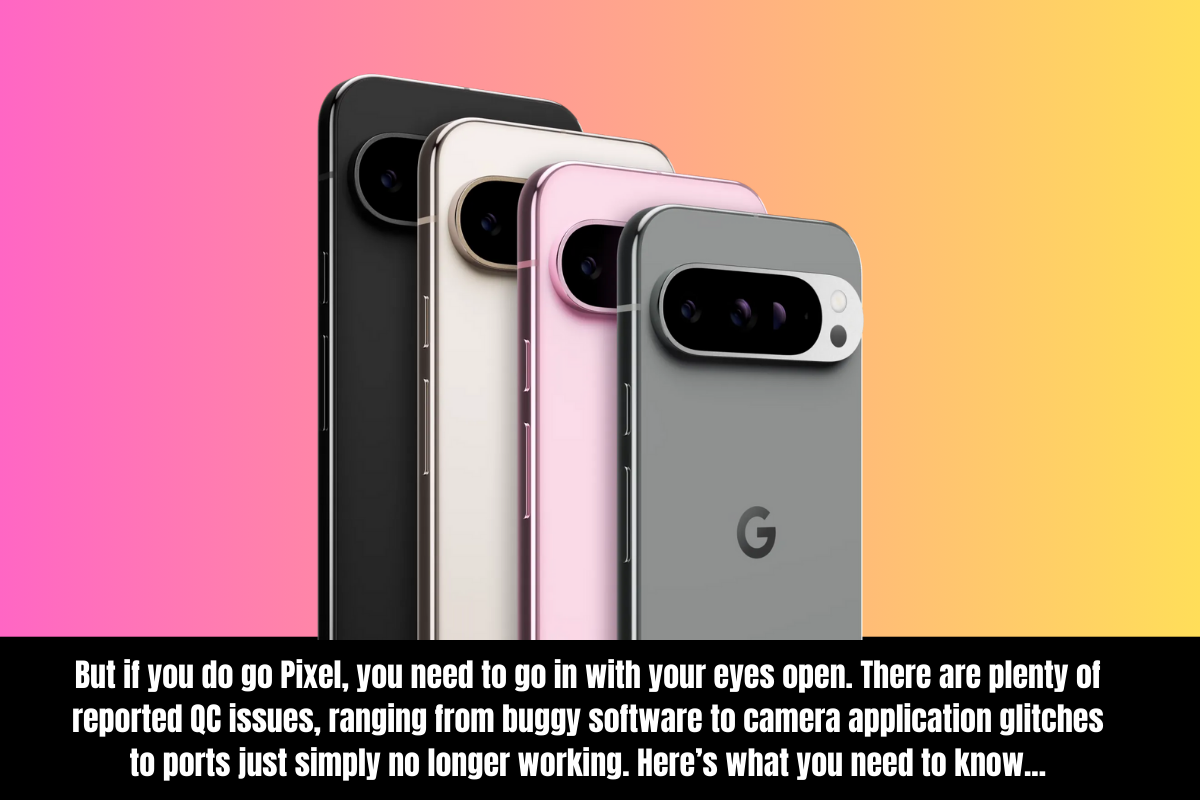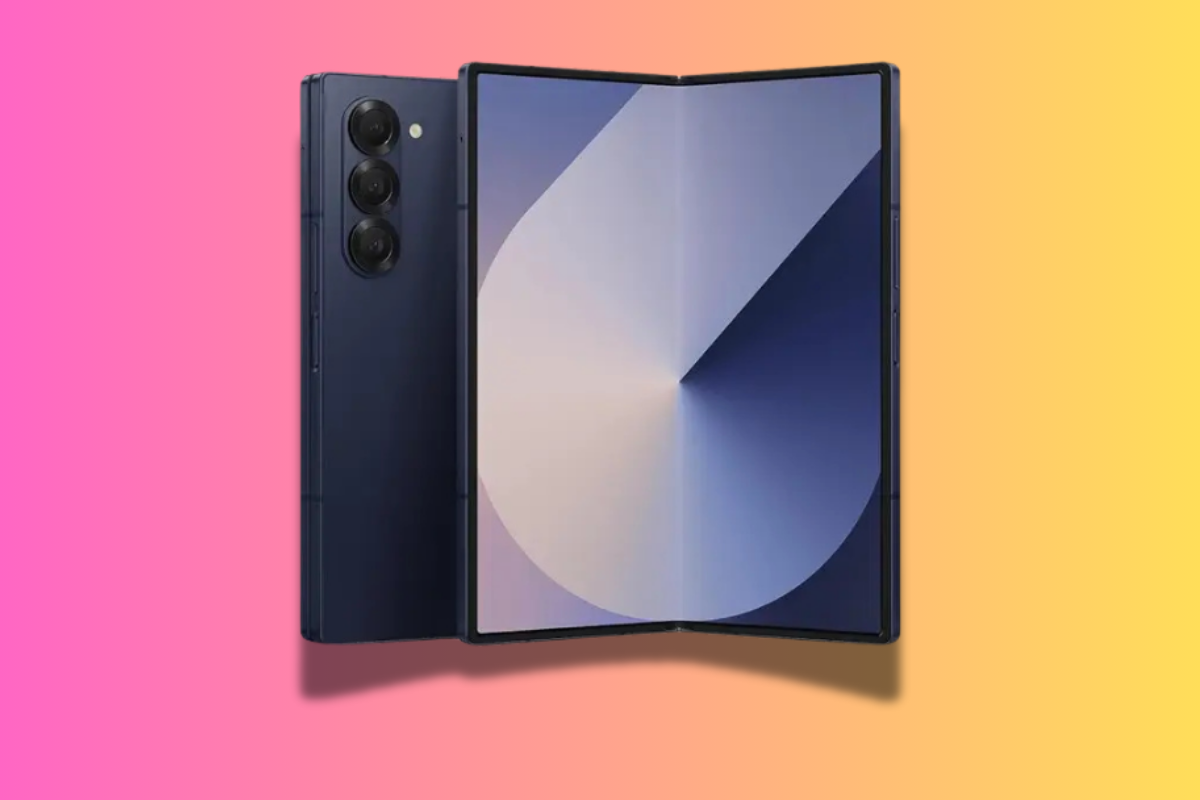Should you buy a Pixel phone over, say, something from Samsung or OnePlus? Let’s investigate…
- Google Pixel Phone: Key Takeaways
- Google Pixel Phones: The Good and The Bad
- Bottom Line?
- What is The Latest Pixel Phone?
- Older, Legacy Pixel Phones Detailed (And Which Are Still Worth Buying In 2024)
- Older Pixel Phone Models
- Google’s Tensor Chipset: What You Need To Know
- The Pixel Phone Difference
- But Which Is The Best Pixel 9 Phone To Get?
- Google Pixel A Series – The Cheaper Pixel Option
- Should You Buy A Pixel Phone?
- Google Pixel Phone PROS – Why You’d Buy One
- Google Pixel Phone Cons – Things To Keep In Mind
Google Pixel Phone: Key Takeaways
Google’s market share has grown a lot these past few years. But Pixel phones aren’t without their foibles. Here’s what you need to know about what it’s like owning a Pixel phone…
The Good Stuff:
- Pixel phones get Android updates faster than any other Android phone. As soon as a new build is shipped, you’ll get it.
- Pixel phones tend to be cheaper than comparable models from Apple, Samsung, and other higher-end brands.
- Google offers mid-range (its A-series), base models, premium models, ultra-premium, and foldable options in its range, so there’s something for everybody.
- Google’s AI smarts inside its newest Pixel phones is arguably the most advanced (and useful) implementation of generative AI on the market.
- Gemini Live, for instance, has myriad applications for both casual and professional users.
- The screen tech, design, and camera technology is very, very impressive across all of its mainline Pixel models.
The Bad Stuff:
- Google has QC problems that you simply don’t get with other brands. I’ve used nearly all of them and nearly all of them have had issues.
- Google’s new Tensor G4 for the Pixel 9 series has issues with throttling under intensive tasks.
- Google is leaning heavily towards AI; if that’s not your bag, you’ll be paying more for features you won’t use.
- The software – despite being designed by Google – can be glitchy at times. Not always. But there’s always complaints on X and Reddit.
Google’s Pixel phones do a lot of things right. In terms of pricing, they’re competitive, undercutting both Apple and Samsung. You also get access, on the newer models, to some of the most advanced AI features on the market.
Add in things like 120Hz displays on all models, very impressive cameras across the board, decent battery life, 7 years’ worth of Android updates, and appealing, smart-looking design, and you might be wondering why isn’t everybody using Pixel phones?
Well, a lot of people are now – Google’s market share has grown a lot these past few years. But Pixel phones aren’t without their foibles. Think of this piece as a warts n’ all guide to what you can expect when you buy a Pixel phone…
Google Pixel Phones: The Good and The Bad

The Good Stuff
Cameras
The camera is where they truly shine. Whether you’re capturing a sunset or snapping a quick shot in low light, Pixel phones make it look easy with tools like Night Sight and Super Res Zoom.
Timely Android Updates
One of the biggest advantages of owning a Pixel is how fast it gets software updates. Just like an iPhone, Pixel phones are first in line when it comes to receiving the latest Android updates and security patches.
This ensures that your device remains secure, smooth, and up-to-date, without having to wait months like other Android brands.
AI Capabilities
Google’s AI-powered features are another reason to love Pixel. Tools like Call Assist automatically screen calls for you, even taking over the hold music, so you don’t have to lift a finger.
The Magic Eraser and Best Take features make photo editing effortless, allowing you to remove unwanted objects and combine the best shots with just a few taps.
Live Translate helps break down language barriers, making travel and communication a breeze.
Google Ecosystem
But what really sets Pixel apart is how seamlessly it integrates with Google’s ecosystem. From the moment you pick up the phone, everything just works—no compromises, no conflicts.
Whether it’s smart suggestions, handy tools, or seamless app integration, Google’s intelligence is built into every aspect of the device, making life easier.
And let’s not forget about security.
Powered by the innovative Tensor chip, Pixel phones offer top-notch security, keeping your data safe and giving you peace of mind in a world where digital security is more important than ever.
TL;DR: What We Love About Pixel Phones
- Unparalleled Cameras: Pixel phones are all about top-notch cameras. With features like Night Sight and Super Res Zoom, you’ll be snapping stunning photos, even in challenging lighting, like it’s no big deal. It’s like carrying a pro-level camera right in your pocket!
- Swift Updates: Like iPhones, Pixel phones enjoy fast and regular software and security updates straight from Google. You stay ahead, keeping your phone running smoothly and securely.
- AI Features: Pixel phones are packed with AI-driven features that take everyday tasks to the next level. Tools like Call Assist can screen calls for you and even handle being on hold, so you don’t have to. With Magic Eraser and Best Take, you can edit photos effortlessly—removing unwanted objects and combining the best facial expressions in group photos. And Live Translate breaks down language barriers instantly, letting you communicate across languages in real time. All these features work together seamlessly, powered by Google’s Tensor chip, making your Pixel phone feel smarter and more intuitive with every use.
- Exclusive Features: With unique features like Live Translate and the Personal Safety app, Pixel phones stand out from other Android devices. You’re getting experiences you just can’t find anywhere else.
- Seamless Google Integration: Everything Google works together effortlessly on a Pixel. You’re experiencing Google at its best, with no compromises or conflicts.
- Smart Touches: The little bits of Google intelligence built into Pixel phones simplify your life. From smart suggestions to useful tools, it’s all about making everyday challenges easier.
- Robust Security: With the innovative Tensor chip, Pixel phones deliver top-tier security, keeping your data safe and giving you peace of mind in a digital world.
The Bad: Things To Keep In Mind
If you’ve used a Google Pixel phone for any length of time, you’ve probably encountered some frustrating issues.
Battery life is one of the first problems you might run into. Despite being a great phone overall, the Pixel can drain faster than you expect, especially with the Tensor chip. Now, this appears to have been fixed on the Pixel 9 series, as I have no experienced this problem on any of my test units.
Another issue I’ve run into is overheating. When you push the phone with intensive tasks like gaming or even just charging it, the device heats up quickly. It can be uncomfortable to hold, and worse, the performance throttles down to cope with the heat.
Then there’s the connectivity side of things. Whether it’s Wi-Fi that drops out unexpectedly, Bluetooth that struggles to pair with devices, or even poor cellular reception, these are annoyances I’ve faced multiple times.
Sure, toggling the settings or restarting the phone might temporarily fix it, but it’s a problem that crops up often enough to be a real hassle. I have come across this issues on the Pixel 6 Pro, Pixel 7, and Pixel 8 – but, again, not any of the Pixel 9 series models (yet).
The display can also be a bit hit or miss. I’ve had issues with the screen flickering, discoloration, and even poor resolution at times on older, legacy models.
Don’t even get me started on auto-rotation—there have been times when the phone just refuses to rotate, no matter how much I try to reorient it.
It’s a small thing, but it’s a little irritating when something that should be automatic isn’t.
The fingerprint scanner has been a letdown too. I’ve found it slow and inconsistent on older models. Sometimes it works perfectly fine, but other times I’m left tapping repeatedly to get it to recognize my fingerprint, which can be frustrating when you’re in a rush.
Software bugs are another area that I’ve experienced firsthand. Random reboots, apps crashing—especially the Google Play Store—are annoyances that I’ve had to deal with multiple times over the years as Google slowly but surely improved its QC processes.
The camera is almost always highlighted as a strong USP for Pixel phones, and in most cases it is. But on older models like the Pixel 7 series and below, the zoom functionality (on ALL models) is rubbish. I’ve also ran into issues shooting in low-light as well.
The Pixel 9 series, notably the Pro models, have fixed many of my ongoing complaints, adding in better zoom and remarkably better overall performance in all lighting conditions.
My advice? Go with the latest Pixel 9 models to avoid 95% of the problems outlined above. As for the hardware QC issues, these types of issues take months to appear, so I’m still actively testing for those. As of right now, though, the Pixel 9 models seem to be very well put together.
Bottom Line?
Google Pixel phones are a mixed bag of extraordinary features and some areas needing improvement.
Google has a history of QC issues and a slew of bugs and issues with its hardware right the way up to its latest models – issues are starting to be reported about the Pixel 9 series.
On a personal note, I’ve owned and used pretty much every single Pixel phone released to date, and most of them had some kind of issue or bug within 6-12 months of usage.
There are plenty of reports about this online, proving that Google – more so than Apple or Samsung – does have inherent quality control issues with its Pixel phones that are not only persistent but aren’t showing any signs of going away.
For updates, AI stuff, camera tech, and general look and feel (design), as well as choice, Pixel phones are great – there’s literally one for everybody inside the Pixel 9 series.
But if you do go Pixel, you need to go in with your eyes open. There are plenty of reported QC issues, ranging from buggy software to camera application glitches to ports just simply no longer working.
This doesn’t mean EVERY Pixel phone is glitchy, far from it, but there is a QC problem inside Google that, for whatever reason, it cannot seem to get a proper handle on.
What is The Latest Pixel Phone?
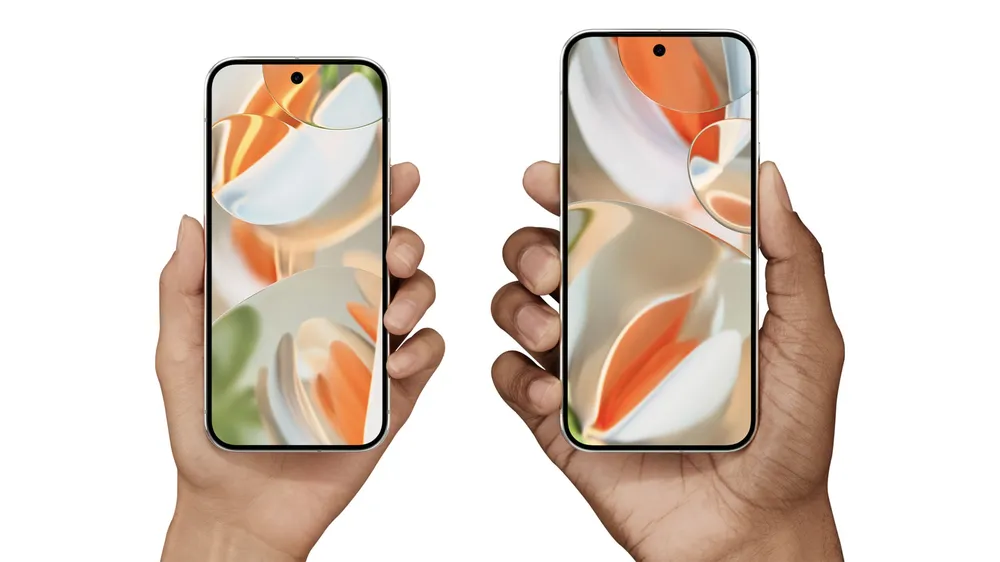
The current latest Pixel phone you can buy is the Pixel 9 series which is made up of the Pixel 9, Pixel 9 Pro, Pixel 9 Pro XL, and the Pixel 9 Pro Fold.
That’s four phones, a first for Google. And this year, it even has an “ultra-flagship” model to do battle with Apple’s Pro Max and Samsung’s Galaxy Ultra models – the Pixel 9 Pro XL.
As per usual, the base model will no doubt by the most popular. It’s price tag ($799.99), features-set, and updated camera and design make it appealing to legacy users and potentially a few floating users bored of either their Apple and/or Samsung phones.
The Google Pixel 9 Series UNPACKED…
Which Pixel 9 model is right for you? There’s four two choose from, so we put together a complete guide to the entire series that details the phones’ specs and hardware and how they’re different.
The Pixel 9 Pro XL is aimed at creators; Google has seem what Apple is doing, courting and converting content creators away from their DSLR cameras, and has finally decided it wants a piece of the action.
The Pixel 9 Pro Fold, meanwhile, is a foldable but is something of a missed opportunity (in the camera department). And at $1799.99, it is also HELLA expensive.
Older, Legacy Pixel Phones Detailed (And Which Are Still Worth Buying In 2024)
Google Pixel Phone Series Comparison
Pixel 8 Series (2023)
Pixel 8 Pro
- Display: 6.7″ QHD+ LTPO OLED, 120Hz
- Processor: Google Tensor G3
- RAM: 12GB
- Storage: 128GB/256GB/512GB
- Camera: 50MP main, 48MP ultrawide, 48MP telephoto
- Battery: 5050mAh
Pixel 8
- Display: 6.2″ FHD+ OLED, 120Hz
- Processor: Google Tensor G3
- RAM: 8GB
- Storage: 128GB/256GB
- Camera: 50MP main, 12MP ultrawide
- Battery: 4575mAh
Key Differences:
- Pro model has larger display, more RAM, and additional telephoto camera
- Pro offers 512GB storage option
- Pro has slightly larger battery
2024 Buying Advice:
The Pixel 8 series is highly recommended in 2024. With the latest Tensor G3 chip, improved cameras, and extended software support, these phones offer excellent value and performance for the current year.
Pixel 7 Series (2022)
Pixel 7 Pro
- Display: 6.7″ QHD+ LTPO OLED, 120Hz
- Processor: Google Tensor G2
- RAM: 12GB
- Storage: 128GB/256GB/512GB
- Camera: 50MP main, 12MP ultrawide, 48MP telephoto
- Battery: 5000mAh
Pixel 7
- Display: 6.3″ FHD+ OLED, 90Hz
- Processor: Google Tensor G2
- RAM: 8GB
- Storage: 128GB/256GB
- Camera: 50MP main, 12MP ultrawide
- Battery: 4355mAh
Key Differences:
- Pro model has larger, higher refresh rate display
- Pro offers more RAM and additional telephoto camera
- Pro has larger battery and 512GB storage option
2024 Buying Advice:
The Pixel 7 series remains a viable option in 2024, especially if found at a discounted price. While not the latest, they still offer strong performance, good cameras, and will receive software updates for a couple more years.
Pixel 6 Series (2021)
Pixel 6 Pro
- Display: 6.7″ QHD+ LTPO OLED, 120Hz
- Processor: Google Tensor
- RAM: 12GB
- Storage: 128GB/256GB/512GB
- Camera: 50MP main, 12MP ultrawide, 48MP telephoto
- Battery: 5003mAh
Pixel 6
- Display: 6.4″ FHD+ OLED, 90Hz
- Processor: Google Tensor
- RAM: 8GB
- Storage: 128GB/256GB
- Camera: 50MP main, 12MP ultrawide
- Battery: 4614mAh
Key Differences:
- Pro model has larger, higher refresh rate display
- Pro offers more RAM and additional telephoto camera
- Pro has slightly larger battery and 512GB storage option
2024 Buying Advice:
While the Pixel 6 series introduced the first-gen Tensor chip, they are not recommended for purchase in 2024. With limited remaining software support and significant improvements in newer models, it’s better to opt for a more recent Pixel phone.
Older Pixel Phone Models
Here’s an overview of Google’s older Pixel phones
From Pixel 6 to Pixel 8
As a lead podcaster at SonicSphere, I spearheaded the creation and production of engaging content across various genres, amplifying audience engagement.
Pixel 8 Series
Pixel 7 Series
Pixel 6 Series
Google’s Tensor Chipset: What You Need To Know

Like Apple, Google wanted to start designing its own custom SoC (system of chip) for its Pixel phone, and in 2021, aboard the Pixel 6 series, it launched its first – rather wobbly – version of its new, AI-focussed mobile processor.
What is Google’s Tensor Chip?
Here’s literally everything you need to know about Google’s Tensor chipset. What it can do, why it exists, and how it is being improved with AI abilities and new features each year
We’re now four generations deep into Tensor’s development, the Pixel 9 series runs the Tensor G4, and while Google has packed in plenty of useful capabilities inside its silicon, including some of the best AI features on the market, Tensor lacks the performance and power of Snapdragon and Apple’s A-series chipsets.
Google’s latest Tensor G4 chip also has some pretty gnarly throttling issues too which is slightly alarming given the positioning of some of its Pixel 9 models like the Pixel 9 Pro XL and the Pixel 9 Pro Fold.
But Tensor is smart and it is useful too, here’s everything else you need to know about the chipset and what it does inside Pixel phones.
Tensor G4 Features & Capabilities
- Enhanced AI Capabilities: With Google Assistant powered by Tensor G4, expect even faster and more accurate Automatic Speech Recognition (ASR). You can run demanding applications like Recorder and Live Caption without worrying about battery drain, thanks to the chip’s optimized power efficiency.
- Improved Communication: The Tensor G4 brings an enhanced Live Translate feature, making it easier than ever to chat in different languages across apps like Messages and WhatsApp. No more switching between apps—translation happens directly in your chat.
- Superior Video Quality: Tensor G4 takes Google’s HDRNet technology to the next level. Now, HDRNet is embedded directly into the chip, allowing it to work in all video modes, even at 4K and 60fps, delivering videos with richer, more vibrant colors.
- Enhanced Security: Tensor G4 isn’t just about performance—it’s also your phone’s first line of defense. Integrated with Titan M2, the chip includes advanced security features like a security core that protects your sensitive data from advanced threats like electromagnetic analysis and voltage glitching. Yes, it even withstands laser attacks!
- Longer Battery Life: Thanks to the efficiency improvements in Tensor G4, the Pixel 9 series boasts better battery life than its predecessors. Whether you’re gaming, streaming, or multitasking, Tensor G4 ensures your phone lasts longer on a single charge.
- Competitive Pricing: Despite its advanced features, the Pixel 9 series continues to offer strong value, with prices that compete directly with top-tier offerings from Apple and Samsung. You’re getting flagship-level performance at a price point that’s easier on the wallet.
With the Tensor G4, Google is setting a new standard for how AI, security, and performance can work together seamlessly in a smartphone. The Pixel 9 series is designed to deliver a smarter, safer, and more efficient experience, all at a competitive price.
The Pixel Phone Difference
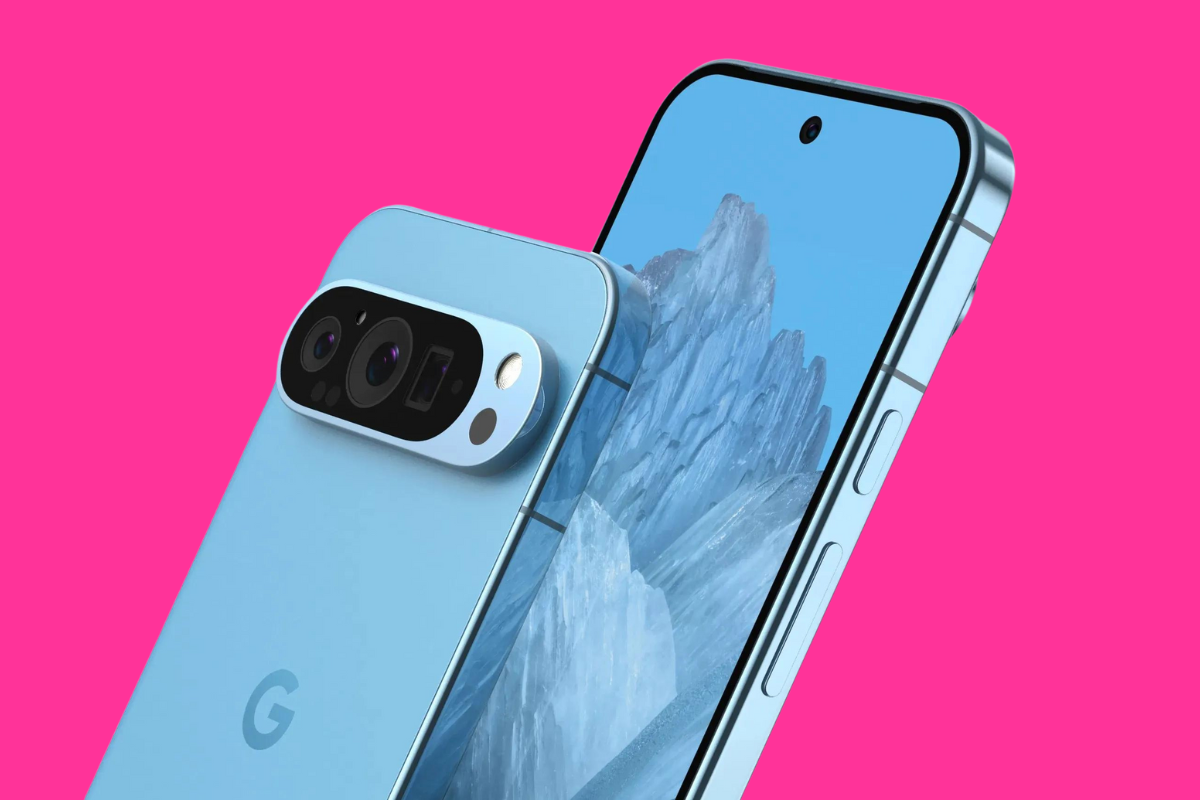
Why do people like Pixel phones? I think it is, mostly, down to two things: the software and the camera tech.
And more recently, Google’s AI features like Gemini Live and the other AI tools that come bundled inside its Pixel phones.
All things being equal, these are the three biggest reasons to get a Pixel phone over, say, a similarly-priced phone from Samsung.
But Which Is The Best Pixel 9 Phone To Get?
We now know why people – in growing numbers; Google’s market share has grown consistently over the past few years – buy Pixel phones. But which of its current models is right for you?
Let’s break it down, shall we? Model by model.
Google Pixel 9 Series Comparison
Pixel 9 Series
Pixel 9
- Display: 6.3-inch FHD+ OLED (90Hz)
- Chipset: Tensor G4
- RAM: 12GB
- Cameras: 50MP main, 48MP ultra-wide, 10.5MP front
- Battery: 4700mAh, 27W wired, 15W wireless
- Price: Starts at $799
Pixel 9 Pro
- Display: 6.7-inch QHD+ LTPO OLED (1Hz-120Hz)
- Chipset: Tensor G4
- RAM: 16GB
- Cameras: 50MP main, 48MP ultra-wide, 48MP telephoto (5x optical zoom), 42MP front
- Battery: 5060mAh, 37W wired, 23W wireless
- Price: Starts at $999
Pixel 9 Pro XL
- Display: 6.8-inch QHD+ LTPO OLED (1Hz-120Hz)
- Chipset: Tensor G4
- RAM: 16GB
- Cameras: Same as Pixel 9 Pro (50MP main, 48MP ultra-wide, 48MP telephoto), 42MP front
- Battery: 5060mAh, faster charging than Pixel 9 Pro
- Price: Starts at $1,199
Pixel 9 Pro Fold
- Display: Super Actua Flex display, largest inner screen
- Chipset: Tensor G4
- RAM: 16GB
- Cameras: 48MP main, 10.5MP ultra-wide with Macro Focus, 10.8MP telephoto (5x optical zoom), dual 10MP front cameras
- Battery: 4700mAh, 45W fast charging
- Price: Starts at $1,799
Key Differences:
- Pixel 9 is the base model with a smaller display and lower refresh rate
- Pixel 9 Pro offers a larger display, higher refresh rate, and improved camera system
- Pixel 9 Pro XL features the largest display and faster charging
- Pixel 9 Pro Fold introduces a foldable design with unique camera setup
2024 Buying Advice:
The Pixel 9 series offers significant improvements over previous generations. The base Pixel 9 provides excellent value, while the Pro and Pro XL cater to users wanting larger displays and advanced features. The Pro Fold is ideal for early adopters of foldable technology. Consider your budget and specific needs when choosing between these cutting-edge devices.
Comparison Table
| Feature | Pixel 9 | Pixel 9 Pro | Pixel 9 Pro XL | Pixel 9 Pro Fold |
|---|---|---|---|---|
| Display | 6.3″ FHD+ OLED, 90Hz | 6.7″ QHD+ LTPO OLED, 1Hz-120Hz | 6.8″ QHD+ LTPO OLED, 1Hz-120Hz | Super Actua Flex Display |
| Chipset | Tensor G4 | Tensor G4 | Tensor G4 | Tensor G4 |
| RAM | 12GB | 16GB | 16GB | 16GB |
| Main Camera | 50MP | 50MP | 50MP | 48MP |
| Ultra-Wide Camera | 48MP | 48MP | 48MP | 10.5MP w/ Macro Focus |
| Telephoto Camera | None | 48MP, 5x optical zoom | 48MP, 5x optical zoom | 10.8MP, 5x optical zoom |
| Front Camera | 10.5MP | 42MP | 42MP | Dual 10MP cameras |
| Battery | 4700mAh, 27W wired, 15W wireless | 5060mAh, 37W wired, 23W wireless | 5060mAh, faster charging than Pixel 9 Pro | 4700mAh, 45W fast charging |
| Price | Starts at $799 | Starts at $999 | Starts at $1,199 | Starts at $1,799 |
Which Pixel 9 Model is Right for You?
- Pixel 9: Best for those who want flagship performance at an affordable price, with solid camera performance.
- Pixel 9 Pro: For those who want advanced camera features, especially with the telephoto lens and higher refresh rate.
- Pixel 9 Pro XL: Perfect if you want the biggest display and faster charging speeds.
- Pixel 9 Pro Fold: Ideal for users who want the versatility of a foldable with top-tier camera and display features.
Google Pixel A Series – The Cheaper Pixel Option

Google’s Pixel A-Series has always been about bringing premium features to the masses at an affordable price, and the latest addition, the Pixel 8a, is no exception. Priced at $499, it continues the tradition of delivering flagship-like performance at a fraction of the cost of high-end smartphones.
A-Series Origins
The A-Series began with the Pixel 3a in 2019, which revolutionized the mid-range market by offering the flagship Pixel camera experience for just $399.
Since then, Google has refined the A-Series with each release, offering improved designs, better cameras, and the latest software features.
The Pixel 4a, Pixel 5a, and Pixel 6a all brought incremental upgrades, making them some of the best value smartphones on the market.
And the Pixel 8a is the current model, although there’ll likely be a Pixel 9a released at some point inside the next 12 months.
The Pixel 8a: Key Features
- Design: The Pixel 8a adopts a similar design language to the Pixel 8, with an aluminum frame, a camera visor, and softer, rounded edges. However, it uses a plastic body to keep costs down and comes with an IP67 water resistance rating, slightly lower than the flagship Pixel models. You can get it in colors like Aloe (green), Bay (blue), Obsidian (black), and Porcelain (white).
- Display: The 6.1-inch Actua OLED display has been upgraded to a 120Hz refresh rate (up from 90Hz on the Pixel 7a) and boasts a peak brightness of 2,000 nits, making it more vibrant and responsive than previous models.
- Performance: Powered by the Tensor G3 chipset, the same chip found in the Pixel 8 and Pixel 8 Pro, the Pixel 8a offers strong AI performance and efficiency. It’s paired with 8GB of RAM and either 128GB or 256GB of storage, which is more storage than the Pixel 7a offered.
- Camera: The camera setup includes a 64MP main sensor and a 13MP ultra-wide sensor. These are the same sensors as the Pixel 7a, but the Pixel 8a benefits from enhanced AI tools, like Magic Editor and Best Take, for improving your photos with minimal effort. The 13MP front camera also offers great quality for selfies and video calls.
- Battery: The Pixel 8a is equipped with a 4,492mAh battery, offering over 24 hours of life on a full charge and up to 72 hours in Extreme Battery Saver mode. It supports 18W wired charging and wireless charging.
Why the A-Series Stays Popular
The Pixel 8a shows why the A-Series remains a favorite among budget-conscious users. It provides a flagship-like experience, including many of the AI features found on the more expensive Pixel 8, but at a much lower price point.
Whether you’re looking for a solid camera, smooth performance, or a bright, responsive display, the Pixel 8a delivers on all fronts without breaking the bank.
The Pixel 8a continues Google’s tradition of offering unbeatable value in the mid-range market, making it a top pick for anyone looking to experience Pixel’s best features at a more affordable price.
Should You Buy A Pixel Phone?
As you can see, there’s quite a lot of stuff to get through when talking about Google’s Pixel phones.
But when it comes to actually buying and using one, there are a few chief reasons why people flock towards Google’s Pixel phones (and also a few reasons why they don’t).
In this post, we’ll look at both the PROS and CONS of Google Pixel phone ownership.
Let’s do this!
Google Pixel Phone PROS – Why You’d Buy One
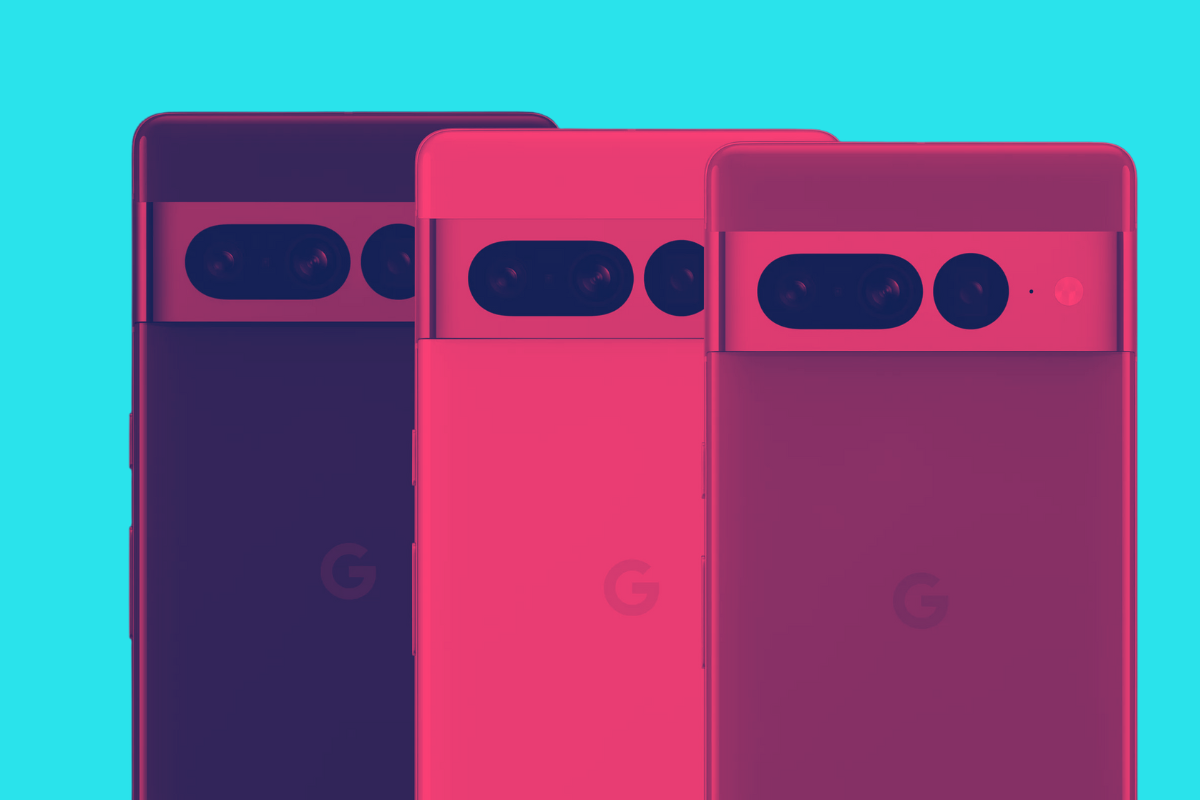
Before we get into the not-so-good stuff, let’s first take a look at why you would buy a Pixel phone.
Or, more specifically, why I decided to use Pixel phones for the past several years instead of – technically more exciting – phones from Samsung, Huawei, and OnePlus.
1. Pixels Phones Are Best For Android Updates
Getting early access to the latest Android updates is one of the main reasons why I – and millions of other people – use Pixel phones. Google designs and makes its Pixel phones. Google also makes Android.
The two are designed to work together seamlessly. And when there’s a new Android update coming, Pixel users ALWAYS get it first. If early access to new Android versions is important to you, Pixel phones are the way forward.
On top of this, ALL new, mainline Pixel phones are guaranteed for 7-years’ worth of Android updates, so if you buy one today you will be getting Android updates for for a good long while.
Samsung has now matched this on some of its phones, but 99.9% of Android phones only ever get two Android updates maximum – some get even fewer. And running the latest build of Android is important too; it keeps you protected from malware and security breaches.
2. Beautiful Software Design
There are BILLIONS of Android phones in circulation today, and they all run on the same operating system – Android. But in order to differentiate their respective products, Android phone companies skin Android with custom software – sometimes called an Android Skin.
These skins vary in look and feel. Some are great (like OnePlus’) and others not so much (like Xiaomi’s). They’re all still Android phones at a source code level, so you get most of the same functionality, but they all look and function slightly differently.
And most aren’t great, either.
With a Pixel phone, you get the purest Android experience possible; it’s Android just as Google intended. Android running on a Pixel phone looks stunning, way better than iOS does on the iPhone. It is also free from ALL the useless bloatware you get on most Android phones.
For me, the software and UX design of Google’s Pixel phones is one of the #1 reasons to go with Pixel over, say, a phone from another Android phone brand. Google’s UX design is flawless, free from bloatware, and super intuitive to use. I could never go back to a custom-skinned Android phone.
3. Google’s Pixel Camera Tech is Amazing
Besides Android updates and software design, Google’s camera tech is the main thing that its Pixel phones are known for. Unlike everybody else in the mobile phone space, Google’s Pixel phones are ALL about doing more with less.
While Samsung and OnePlus are adding in more and more lenses, Google is working on ways to make its camera software smarter. This approach has worked too; Google’s Pixel phones (even the cheap ones) constantly top “best camera” lists all around the web.
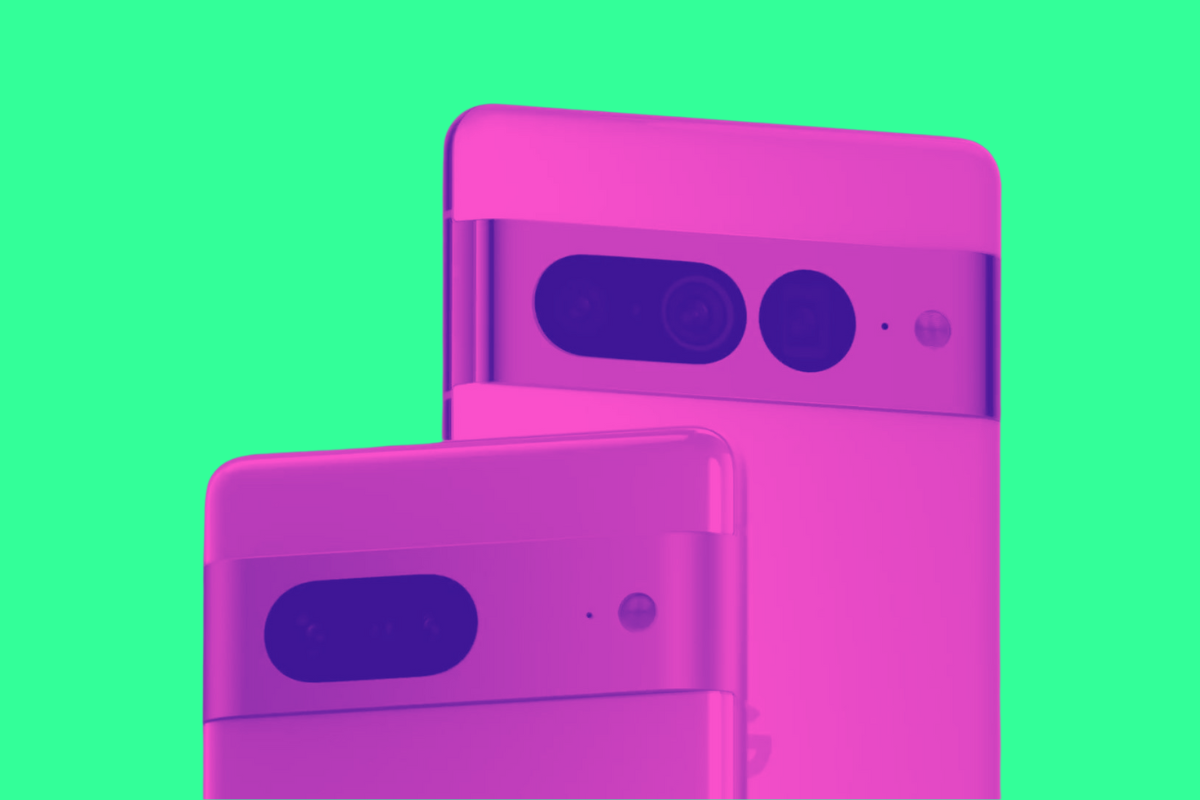
Rather than shoe-horning a myriad of hardware into a phone, Google’s approach to camera technology focuses on fewer physical components and more machine learning – AI, to you and me.
With machine learning in place, Google’s camera can capture better images than some Android phones that have twice the amount of lenses.
Google’s secret sauce is essentially a combination of machine learning (AI) and its image processor. Combined with things like HDR+, this helped Google create one of the most powerful (and easy-to-use) mobile phone cameras on the planet.
4. Simplicity – Pixel Phones Focus on Utility, Not Gimmicks (Most of The Time)
As phones have gotten bigger, they’ve got more complex. Bigger phones, more features, multiple camera lenses that most people don’t use – all of these things have combined to inflate the price of phones.
And that’s not exactly good for the consumer. Around the launch of the Pixel 3a, Google stumbled onto something, something it originally discovered back around the time of its Nexus 4 phone: that people ACTUALLY just want affordable, good-quality phones.
The Pixel 3a was Google’s best-selling Pixel phone to date. For this exact reason: it was awesome and it was cheap. And Google’s Pixel A series phones have been a firm favorite with consumers ever since.
The latest Pixel A series model is the Pixel 8a, and it is well worth a look if you’re after a cheaper Android phone that packs a massive punch.
5. The “Not-So-Flagship-Flagship” Phone
By 2024, Google’s approach to the smartphone market has solidified, offering a range of devices that cater to different budgets while consistently delivering strong value and performance. The company now positions its Pixel lineup into three categories: the base model, the Pro model, and the A series model, all designed to meet varying consumer needs without the sky-high price tags associated with other flagship devices.
Pricing Strategy
The Pixel 9 continues this tradition, starting at a competitive price that undercuts major rivals like Apple and Samsung. For instance, in 2023, the Pixel 9 base model starts at $799, while the Pixel 9 Pro begins at $999—prices that remain significantly lower than what Apple charges for its iPhone 15 lineup. This means that with Google, you’re getting flagship-level performance, cutting-edge AI features, and a top-notch camera system for less than what you’d pay for competing models.
And it’s not just about the price tag—Google’s Tensor G4 chipset powers the Pixel 9 series, further enhancing performance, AI capabilities, and battery efficiency. By designing and developing its chips in-house, Google has greater control over the optimization of its software and hardware, leading to better integration and performance—similar to Apple’s approach with its A-series chips. Plus, by avoiding reliance on third-party chip manufacturers like Qualcomm, Google is able to keep costs down, a benefit it passes on to consumers.
The Pixel Experience
Google’s hardware is complemented by its clean Android experience, which offers exclusive features and timely updates that make Pixel devices stand out. And like Apple, Google has recognized that not everyone is willing to pay over $1,000 for a smartphone. This awareness has led to a pricing strategy that resonates with a wider audience, offering premium features at prices that are easier to stomach.
While Google dipped its toes into the ultra-premium market with the Pixel 6 Pro and continued that trend with the Pixel 7 Pro, the company has managed to keep its devices more affordable than most other flagships. The Pixel 9 series follows suit, offering high-end features at a price point that’s still below the market average for flagship devices.
But it now also does an ultra-premium model in the form of the Pixel 9 Pro XL which is aimed squarely at pro-users and creators.
Google Pixel Phone Cons – Things To Keep In Mind
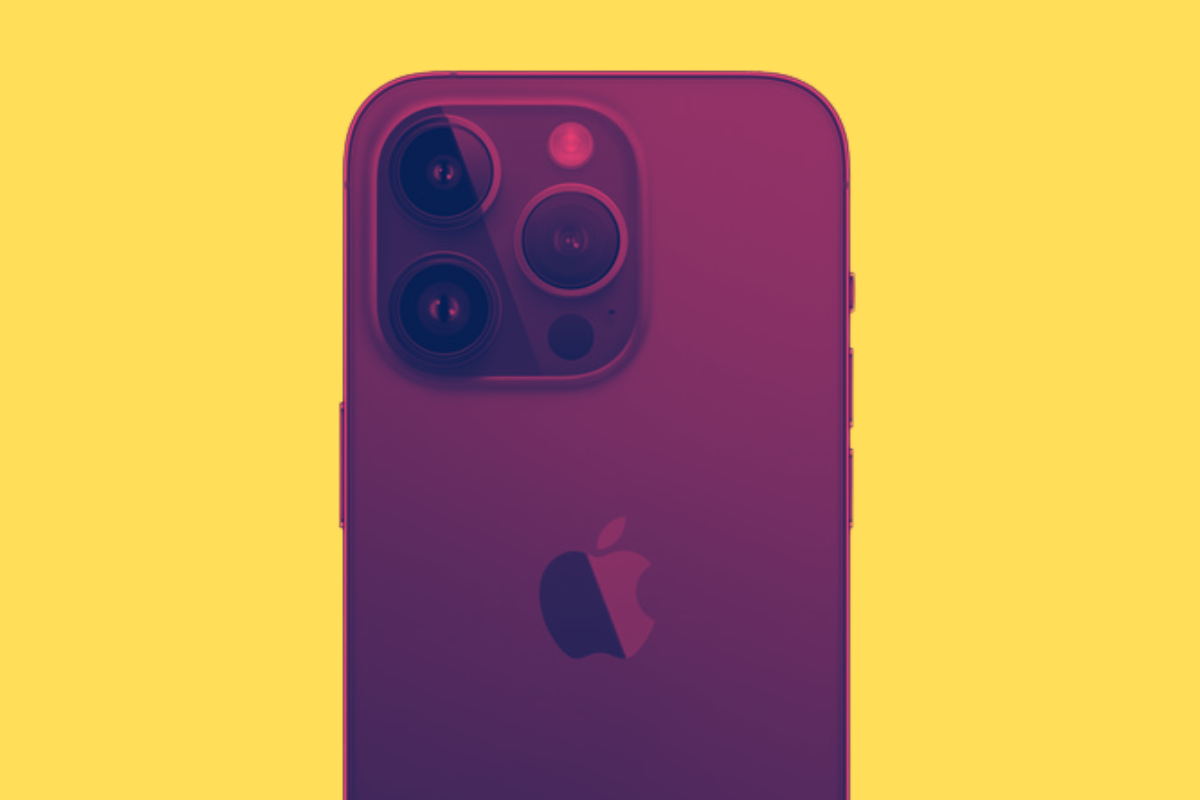
Google’s Pixel phones – in my humble opinion – are great; they tick nearly all of my boxes with respect to performance, software, and usability. But there are definitely some things, not issues per se, but factors you should know about before you commit to buying a Pixel phone.
Below, I’ll give you a quick overview of things that Google’s Pixel phones don’t do especially well, as well as areas where other phones do things better.
Funky Issues Plagued Older Pixel Phones
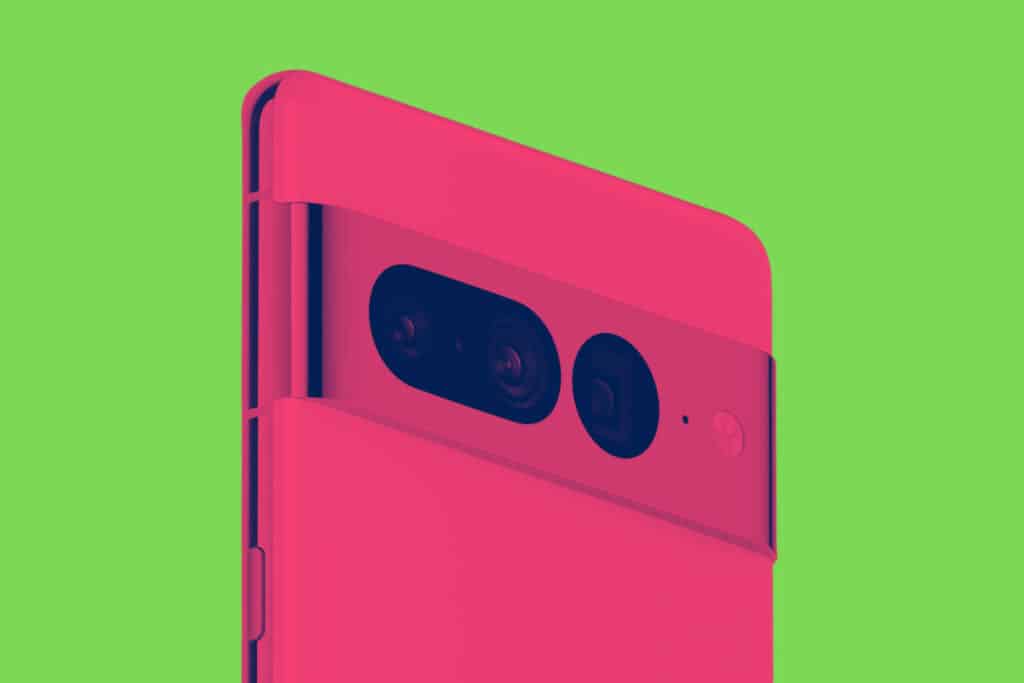
Google’s first few generations of Pixel phones, while impressive, weren’t without their problems. There were issues with the OLED panels on certain models, problems with the charging ports on some, and my Pixel 2 XL just stopped working for no apparent reason. I still don’t know what happened.
The Pixel 3 and Pixel 3 XL weren’t loved either. But all agreed that one thing remained constant throughout all the ups and downs: Google’s software was still the best available version of Android you could use and its camera tech kicked A LOT of ass.
With the Pixel 6 and Pixel 7, Google has finally hit its stride. The design is on point. The specs and pricing make sense. And the camera tech has evolved to bring even more performance.
And this continued with the Pixel 8 series and the new-look Pixel 9 models.
Basically, Google has finally found its own special niche in the phone market, a place that should help it make a lot of new friends and converts in 2024 and beyond.
There’s still the worry about QC issues but for the most part Pixel phones are now starting to really show their true potential.
OK, that’s basically my 2¢ on Google’s Pixel phones. As you can probably tell, I like Pixel phones. For me, they’re the most utilitarian (in a good way) phones on the market.
And if you want my advice on which one to get? I’d recommend the Pixel 9 Pro – it packs in everything you’ll ever need from a smartphone and a whole load more (and it is way cheaper than a Pro / Pro Max iPhone from Apple).
